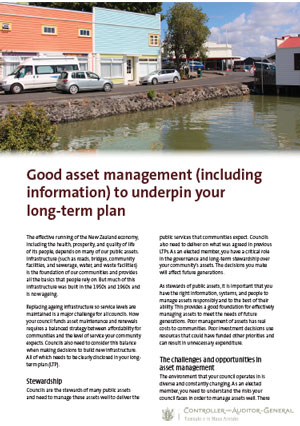Good asset management (including information) to underpin your long-term plan
The effective running of the New Zealand economy, including the health, prosperity, and quality of life of its people, depends on many of our public assets. Infrastructure (such as roads, bridges, community facilities, and sewerage, water, and waste facilities) is the foundation of our communities and provides all the basics that people rely on. But much of this infrastructure was built in the 1950s and 1960s and is now ageing.
Replacing ageing infrastructure so service levels are maintained is a major challenge for all councils. How your council funds asset maintenance and renewals requires a balanced strategy between affordability for communities and the level of service your community expects. Councils also need to consider this balance when making decisions to build new infrastructure. All of which needs to be clearly disclosed in your long-term plan (LTP).
Stewardship
Councils are the stewards of many public assets and need to manage these assets well to deliver the public services that communities expect. Councils also need to deliver on what was agreed in previous LTPs. As an elected member, you have a critical role in the governance and long-term stewardship over your community’s assets. The decisions you make will affect future generations.
As stewards of public assets, it is important that you have the right information, systems, and people to manage assets responsibly and to the best of their ability. This provides a good foundation for effectively managing assets to meet the needs of future generations. Poor management of assets has real costs to communities. Poor investment decisions use resources that could have funded other priorities and can result in unnecessary expenditure.
The challenges and opportunities in asset management
The environment that your council operates in is diverse and constantly changing. As an elected member, you need to understand the risks your council faces in order to manage assets well. There are many factors to consider, including but not limited to:
- the current condition and performance of the assets;
- changing regulatory requirements in the operating environment;
- the changing demographics and expectations of your community driving different service level needs;
- climate change; and
- risks presented by historical investment choices.
Risks present both challenges and opportunities that councils need to consider when making investment decisions. New Zealand does not have the economies of scale of many other countries. Therefore, careful thought is needed about investments to optimise services for communities and to build resilience.
Making good decisions about asset investment
As an elected member, you should be confident that your council has a sound case for investing in new assets and has clearly defined the benefits being sought.
Councils should have a clear asset renewals strategy that drives its decisions and strikes the right balance between maintenance (that is keeping existing assets working and in good condition) and renewal (replacing them because they are at the end of their useful life, no longer working properly, or are more cost effective to replace than continue to maintain). This strategy also needs to be made clear to the people in your community so they understand the decisions you are making on their behalf.
You also need good information when it comes to decisions about maintenance and renewals of your existing assets. Councils might not have detailed condition and performance information about all of their assets, but you should have this level of detailed information about your critical assets. Critical assets are those assets that, if they failed, would have a significant adverse effect on essential services. Without adequate reinvestment in critical assets, there is an increased risk of failure and service disruption. In all cases, you should have reasonable information about the age of your assets.
Councils cannot separate decisions about renewing their assets from considerations about how they are funded and the timing of renewals. In some cases, the funding options available to your council might be constrained by its present financial situation. You must be aware of this starting point. Our previous work has also noted that councils’ historic renewals investment remains lower than expected. We are concerned that some councils might be building up a backlog of asset deferrals. This can pose a risk to current service delivery and future affordability.
Regardless of how your council decides to fund asset renewals, there needs to be a strategic conversation about the trade-offs of that funding option (particularly as you make decisions about the affordability to your community) and the future implications of that decision. This information needs to be provided in a transparent way to your community.
Questions for elected members to consider:
- Are you receiving the information you need to ensure that there is effective planning for, and management of, assets?
- Do you clearly understand, and have you considered, the challenges and opportunities your community faces in order for your assets to be managed well?
- Have you been realistic and used reasonable assumptions to inform your asset renewals strategy?
- Do you have systems where the data about assets can be readily analysed and used to manage those assets?
- If your council is planning on consulting on the construction of new assets in your LTP, are you confident that there is a sound and appropriate business case for this new investment?
- Do you have enough assurance that your council is investing in its infrastructure at appropriate levels to ensure that the intended level of service will be delivered now and in the future?
- Can you tell your story to the community so that they are clear on what they are paying for and what level of service they can expect?
- Do you have a backlog of maintenance or deferred renewals? If so, what are you doing about it?

